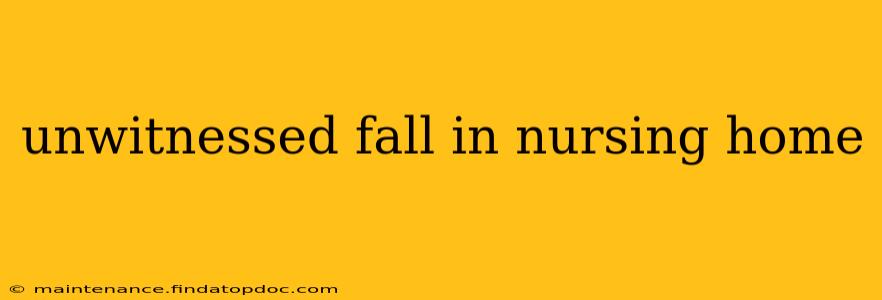Falls are a significant concern in nursing homes, and unwitnessed falls pose an even greater challenge. They often go unreported, leading to delayed treatment and potentially serious consequences for residents. Understanding the risks, prevention strategies, and what to do if a fall occurs is crucial for families and caregivers. This guide delves into the complexities surrounding unwitnessed falls in nursing homes, providing valuable insights and actionable information.
What is an Unwitnessed Fall in a Nursing Home?
An unwitnessed fall is precisely what it sounds like: a fall that occurs without anyone present to see it happen. This lack of direct observation makes it difficult to determine the cause, the severity of the injury, and the immediate need for medical attention. The resident may not even report the fall themselves, especially if they are experiencing confusion, disorientation, or pain. This makes early detection and intervention critically important.
Why are Unwitnessed Falls So Dangerous?
The dangers of unwitnessed falls extend beyond the immediate physical injury. Because the fall is unseen, the following complications can arise:
- Delayed medical attention: The resident may not receive prompt treatment for fractures, internal bleeding, or head injuries.
- Missed opportunities for prevention: Without knowing the cause of the fall, preventative measures can't be effectively implemented.
- Increased risk of further falls: Underlying conditions that contributed to the fall may remain unaddressed, increasing the likelihood of future falls.
- Increased risk of complications: Untreated injuries can lead to infections, pressure sores, and other complications, potentially impacting the resident’s overall health and quality of life.
- Emotional distress: Falls can be frightening and lead to fear and anxiety, potentially impacting the resident's mental well-being.
What are the Common Causes of Unwitnessed Falls in Nursing Homes?
Several factors can contribute to unwitnessed falls. These often overlap and interact:
- Underlying medical conditions: Conditions like Parkinson's disease, stroke, dementia, and medication side effects can impair balance and coordination, increasing fall risk.
- Environmental hazards: Poor lighting, cluttered floors, slippery surfaces, and inappropriate footwear all contribute to the risk of falls.
- Physical limitations: Weakness, decreased mobility, and vision impairments can make residents more prone to falls.
- Medication side effects: Many medications, especially those for heart conditions or blood pressure, can cause dizziness or lightheadedness, leading to falls.
- Lack of staff supervision: Insufficient staffing levels can mean residents are left unsupervised for extended periods, increasing the chance of unwitnessed falls.
How Can Unwitnessed Falls be Prevented?
Proactive measures are key to reducing the occurrence of unwitnessed falls. These include:
- Regular assessments: Comprehensive assessments of residents' physical and cognitive abilities should be conducted regularly to identify individuals at high risk of falling.
- Environmental modifications: Nursing homes should ensure well-lit hallways, remove clutter, and use non-slip mats in bathrooms. Appropriate footwear should be provided and encouraged.
- Medication review: Regular review of medications can identify and address side effects that may increase fall risk.
- Fall risk reduction programs: Implementing comprehensive fall risk reduction programs, including exercise programs and individualized care plans, are vital.
- Increased staff supervision: Adequate staffing levels are crucial to ensure that residents are closely monitored and receive assistance when needed. Consider using assistive devices like call bells and alarms.
- Improved communication: Open communication between staff, residents, and families is vital to identify and address potential fall risks.
What Should You Do If You Suspect an Unwitnessed Fall?
If you suspect a resident has experienced an unwitnessed fall, take the following steps:
- Check the resident immediately: Assess the resident's condition for injuries, pain, or signs of distress.
- Notify nursing staff immediately: Report your concerns to a nurse or other healthcare professional.
- Document the incident: Record the time, date, location, and any observations of the resident's condition.
- Advocate for the resident: Ensure the resident receives appropriate medical attention and follow-up care.
How Can Families Help Prevent Unwitnessed Falls?
Families can play a crucial role in preventing unwitnessed falls by:
- Staying informed: Regularly communicate with nursing home staff about the resident's condition and any concerns.
- Visiting frequently: Regular visits allow for closer monitoring and identification of potential problems.
- Advocating for the resident: Don't hesitate to raise concerns about staffing levels, environmental hazards, or medication side effects.
What are the legal implications of unwitnessed falls in nursing homes?
Unwitnessed falls can have significant legal ramifications for nursing homes. Failure to provide adequate care and supervision can lead to negligence claims from residents or their families. Thorough documentation and proactive fall prevention strategies are essential to mitigate legal risks.
Are there any specific technologies to help prevent unwitnessed falls?
While no technology can completely eliminate the risk of falls, several technologies can assist in detection and prevention. These include wearable sensors that detect falls and alert staff, pressure sensors in beds and chairs, and smart cameras that monitor resident activity. The effectiveness of these technologies varies, and implementation often depends on individual facility capabilities and resident preferences.
By understanding the risks associated with unwitnessed falls, implementing effective prevention strategies, and knowing how to respond when a fall occurs, we can significantly improve the safety and well-being of nursing home residents. Open communication and collaboration between families, caregivers, and nursing home staff are crucial to create a safer environment for all.
